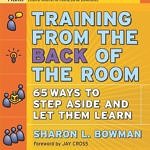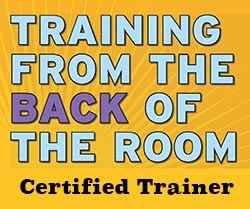5 Ways to Check for Understanding
 You just finished a customer service training for a small group of your company’s employees. They listened attentively the whole time your were talking. Now you stop and ask, “Do you understand?” They nod their heads. You continue, “Do you have any questions?” They shake their heads. “Good,” you think. “They’ve got it.” Or do they?
You just finished a customer service training for a small group of your company’s employees. They listened attentively the whole time your were talking. Now you stop and ask, “Do you understand?” They nod their heads. You continue, “Do you have any questions?” They shake their heads. “Good,” you think. “They’ve got it.” Or do they?
Or do they? During the next few days, these employees make a number of decisions that cause you to wonder, “Didn’t they HEAR what I told them? If they had only LISTENED, they’d know the right thing to do!” You end up spending precious time helping them correct their mistakes and reviewing the information you already gave them. Meanwhile, your company loses productive time (and perhaps a customer or two) while you re-teach and retrain.
So how do you make sure your trainees “get it” the first time you say it? How do you know if they REALLY understand what they hear? There is a simple answer to these questions: You check for understanding. This means YOU stop talking and ask your trainees to SAY or DO something with the information you just gave him.
Here are five “check-for-understanding” strategies that will give you a good indication of whether or not your trainees understand, remember, and can apply what they have heard.
1. Repeat-Back: Commercial pilots do it all the time because it’s part of the FAA flight regulations. Pilots repeat aloud what the flight control tower tells them to do. This verbal repetition of information serves two purposes: 1. It lets the control tower know if the pilot heard and UNDERSTOOD the information correctly; 2. It gives flight control the opportunity to IMMEDIATELY correct any mistakes in hearing, which, in the case of air travel, can save lives.
No, you don’t say to your trainees, “Repeat what I just said so I can see if you’re listening or not.” Instead, you ask them to tell you what they just heard so you can make sure you didn’t leave anything out. Or you tell them to repeat what they learned to make sure you explained it clearly enough. Or you ask them to tell each other the two (or three or four) most important things they remember from the information you just shared. The Repeat-Back will give you immediate feedback as to what they do and don’t understand.
 2. Think-Back: Also called “active reflection,” the Think-Back gives learners time to think about what they have heard. According to David Meier, director of the Center for Accelerated Learning and author of The Accelerated Learning Handbook, learners need “to reflect on experience and to create connections, meanings, and values” out of new information.
2. Think-Back: Also called “active reflection,” the Think-Back gives learners time to think about what they have heard. According to David Meier, director of the Center for Accelerated Learning and author of The Accelerated Learning Handbook, learners need “to reflect on experience and to create connections, meanings, and values” out of new information.
You ask your trainees to think about the new customer service information and how it fits with what they already know. Or you ask them to share a comment or a question about what they heard you say. Or they take turns telling you one way they might be able to use the new information when working with customers. Again, you will get a clearer picture of what your trainees do and don’t understand from the Think-Back dialogue.
3. Teach-Back: You know your information upside down and inside out. Why? Because you’ve taught it often enough so that you’ve mastered what you teach. Your trainees need to do the same thing: They need to teach the information to each other in order to master it.
You direct your trainees to pair up and to pretend that one person is the “teacher” and one is the “student.” The student asks questions about the new customer service information (as if he doesn’t know the answers) and the teacher explains the answers. Then they switch roles and repeat the procedure, asking different questions. You listen to their conversations and affirm what they say or correct any misunderstandings. Your trainees can also give each other corrective feedback.
4. Play-Back: What many people call “role-play,” author Robert Lowe calls “improv.” In his book Improvisation, Inc., Lowe documents the power of this strategy as a communication, evaluation, and feedback tool. It follows then, that the improv or “Play-Back” is another useful (and fun) way to check for understanding.
You tell your trainees you are going to do a Play-Back with them to review the most important points of the new customer service information. You describe yourself, the situation, and the roles they will take. You “become” the person you described and your trainees improvise what they would do and say in that situation. The Play-Back can be short – a minute or two – and humorous if you want to ham it up a bit. More importantly, it can reveal how well your trainees are able to apply the new information to a specific work situation.
 5. Report-Back: Learning doesn’t end when the information-giving time ends. When a learner applies new information to specific work situations, the learner needs to report and evaluate the results, and get feedback from the person who taught him or from qualified colleagues. Sivasailam “Thiagi” Thiagarajan, president of Workshops by Thiagi and author of Design Your Own Games and Activities, calls this “The Law of Practice and Feedback.” Thiagi says, “Learners cannot master skills without repeated practice and relevant feedback.”
5. Report-Back: Learning doesn’t end when the information-giving time ends. When a learner applies new information to specific work situations, the learner needs to report and evaluate the results, and get feedback from the person who taught him or from qualified colleagues. Sivasailam “Thiagi” Thiagarajan, president of Workshops by Thiagi and author of Design Your Own Games and Activities, calls this “The Law of Practice and Feedback.” Thiagi says, “Learners cannot master skills without repeated practice and relevant feedback.”
You arrange with your employees to check back with you at the end of the day (or week), either in person or through email, text messages, phone calls, or a company communication site designed for the purpose of giving/receiving feedback.
You tell your trainees that you want to know how they used the information they learned, what the results were, and if they encountered any difficulties along the way.
After this Report-Back, you give them positive feedback. You might tell them a “glow” and a “grow,” i.e. kudos for what they have done that worked well, and a suggestion for improvement or for going a step further and making it work even better. Or you might ask them to evaluate themselves, and then add your comments to theirs. In effect, you’re checking for long-term understanding and application of the information.
Conclusions: When you use these “Checking for Understanding” strategies, you’ll know if your trainees not only HEARD the new information, but can DEMONSTRATE their understanding by EXPLAINING it and APPLYING it to specific work situations.
Furthermore, they will feel more confident that they can use the new information when they need to. You don’t have to waste valuable company time reteaching and retraining. By checking for understanding both during and after you share new information with your trainees, you create a win-win learning experience for you, your employees, and your company.
NOTE: This blog post has been updated for 2018 to include more “check for understanding” details.
*********************
 If you really really like knowing the “cognitive neuroscience” behind brain-based presenting and training, consider attending my 2-day “Training from the BACK of the Room” class – the only public TBR class that I will be facilitating for Spring/Summer 2018. The class will be held in Minneapolis MN on April 12th – 13th 2018. Click HERE for details and registration information (there are still seats left). Click HERE for a calendar of all TBR classes for 2017 – 2018 (classes are being added monthly so check back).
If you really really like knowing the “cognitive neuroscience” behind brain-based presenting and training, consider attending my 2-day “Training from the BACK of the Room” class – the only public TBR class that I will be facilitating for Spring/Summer 2018. The class will be held in Minneapolis MN on April 12th – 13th 2018. Click HERE for details and registration information (there are still seats left). Click HERE for a calendar of all TBR classes for 2017 – 2018 (classes are being added monthly so check back).
 I will also be facilitating the 1-day Trainer Certification Course following the 2-day TBR class in Minneapolis. This 1-day Trainer Certification Course will give you everything you need to be able to present the “official” 2-day TBR class for your own clients, customers, companies, and educational institutions. (Note: You must have attended a 2-day TBR class in order to attend the 1-day Trainer Certification Course.)
I will also be facilitating the 1-day Trainer Certification Course following the 2-day TBR class in Minneapolis. This 1-day Trainer Certification Course will give you everything you need to be able to present the “official” 2-day TBR class for your own clients, customers, companies, and educational institutions. (Note: You must have attended a 2-day TBR class in order to attend the 1-day Trainer Certification Course.)
As of now, the dates for the April 2018 Trainer Certification Course are sold out. However, there is a wait-list and, if enough people are interested, the sponsoring company (The Braintrust Consulting Group) may open up another Cert Course day. We should know by January 2018 whether we have enough interested people to do this.
Click HERE for more information and registration/sign-up for the wait-list for the April 2018 Trainer Certification Course.
Don’t forget to check out the free give-aways on my website’s “What’s New?” page while you’re here 🙂 And please pass this information along to anyone who is interested in exciting, unforgettable, learner-centered, brain-based instruction.